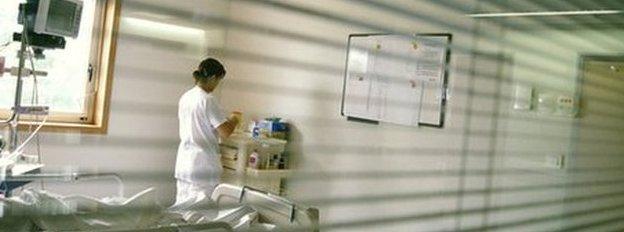Are there enough nurses in the NHS?
- Published

Nurse numbers have been falling in recent years
Health Secretary Jeremy Hunt has pledged to restore trust in the NHS in his response to the public inquiry into the Stafford Hospital scandal.
Central to his plans is the move to get hospitals to be open about whether they have enough staff on their wards.
The measure has been widely welcomed, but it raises the question whether there are enough nurses working in the NHS to ensure high standards.
Since the news broke I have been contacted by nurses complaining they are severely understaffed on the wards they work on.
To be fair, Health Secretary Jeremy Hunt has acknowledged there is a problem.
In an interview with the BBC, he admitted: "We are going to need more nurses."
But how many?
According to official data from the Health and Social Care Information Centre, there are just under 307,000 midwives and nurses working in England (in terms of full-time equivalent posts).
Once you strip out the midwives, health visitors and school nurses, which are not employed by the NHS, there are about 275,000 nurses working across the health service in both hospitals and community services.
That represents a drop of 6,000 - or 2% - since the election.
'Francis effect'
It has created a situation whereby some wards, according to Unison's head of health Christina McAnea, can be said to be "dangerously under-staffed".
A recent study by the National Nursing Institute seems to confirm this.
It found that half of hospitals are regularly running wards with fewer than one nurse to every eight patients.
The one-to-eight ratio is considered the minimum level - below this research shows that an average-sized hospital could expect to see as many as 20 extra deaths a year.
It is likely when the new NHS system gets up-and-running next year that the ratios will be much better than that on some wards.
The government has yet to decide exactly which measure of safe staffing it will use.
However, where such recommendations have been deployed on wards - in places such as Australian and the US and some of the more innovative NHS hospitals - one-to-five and one-to-four ratios for wards dealing with children, the dying and surgical patients have been adopted.
To help fill this gap, the government has pointed to what it calls the "Francis effect" with hospitals jolted into recruiting more staff. It is forecasting that by the end of this financial year they will be employing an extra 3,700 nurses.
Skill mix
Only time will tell if that actually happens.
One concern being raised is that the NHS may simply shift nurses from the community to hospitals, resulting in no net gain overall.
That would seem strange considering last week's review of A&E units called for more to be done in the community.
What is more, it could still leave the NHS short.
Work, external by the Royal College of Nursing suggests the NHS may actually be as many as 20,000 nurses short of what it needs.
But it is not just about numbers. Skill mix is important too.
For example, some nurses can prescribe, some can't.
The support they receive from healthcare assistants varies too.
Some do no nursing roles, while others have been trained to change dressings and monitor a patient's vital signs.
As in any work environment a mix of experienced and junior staff is needed.